The South Loop of Yellowstone, also known as the Lower Loop, is home to some of the most famous landmarks and top sights of Yellowstone National Park. The Old Faithful Geyser and the colorful Grand Prismatic Spring are located here, to mention just a few. But there’s a lot more to see and do along the southern loop of Yellowstone!
In this article, we highlight all the main sights and places not to miss when visiting the south side of Yellowstone. For each place, we also include practical tips and info so that you know what to expect.
In addition, to help you plan your visit, we also created a MAP indicating all the best places to see along Yellowstone’s South Loop. You can find it at the bottom of this article.
I hope that this guide will inspire you to explore the south part of Yellowstone National Park deeper. Take a look!
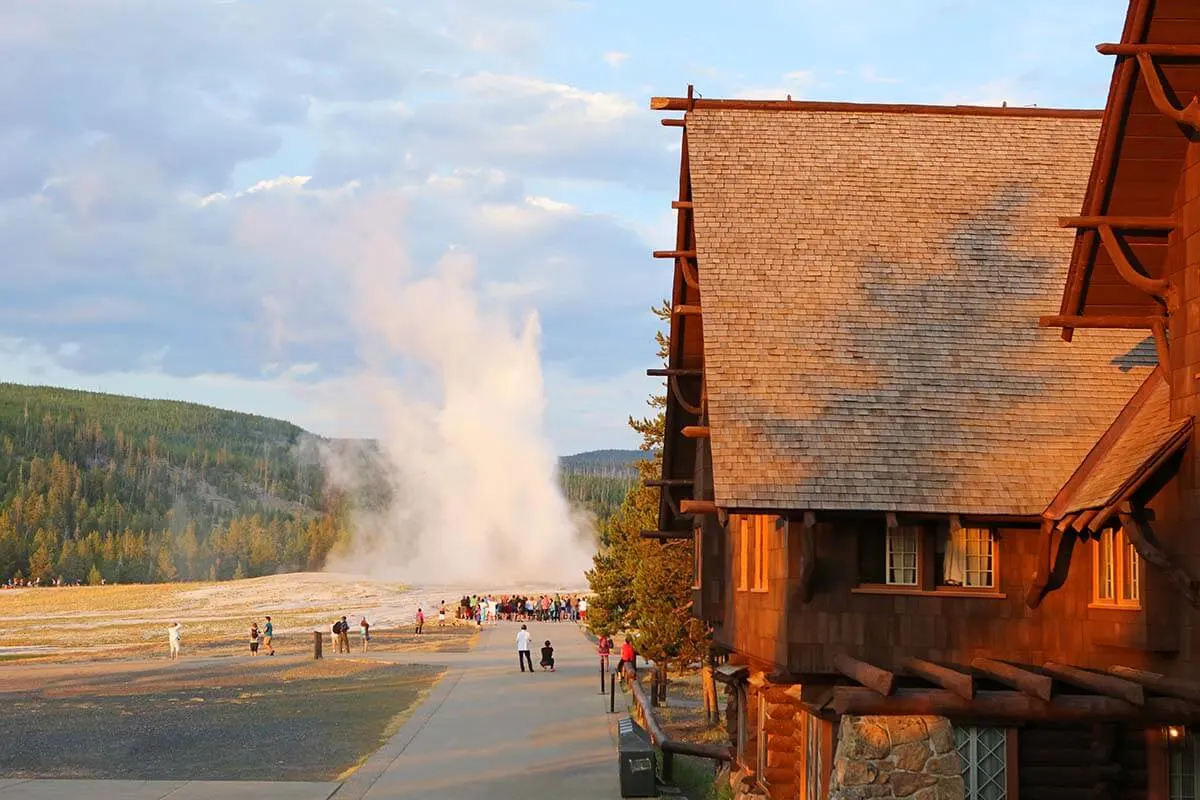
Important: Be sure to check the official website for up-to-date information on any closures or road works before you visit.
Good to know: To help you plan your trip, we list the main sights of the Yellowstone lower loop in sequential order, clockwise. We start with the Old Faithful Geyser, followed by the Grand Prismatic Spring, etc. Since you’ll be driving the entire loop anyway, you can just start at any point and visit all these places in an order that makes the most sense for your itinerary.
Of course, you can drive the Lower Loop of Yellowstone in any direction too – clockwise or anticlockwise, and there’s really no advantage or disadvantage doing it one way or another. It depends purely on where you are staying and where you’ll start and end your drive (see also our guide on where to stay in and near Yellowstone).
This list contains all the best stops on the lower loop, including a few hikes. To help you decide where to go depending on how much time you have, you’ll see that we marked each stop as ‘must-see’, ‘nice-to-see’, and ‘if you have more time’. We also included an estimated time you’ll need for each stop.
READ ALSO: Yellowstone Lower Loop 1 Day Itinerary
TIP: If you find the practicalities of visiting Yellowstone overwhelming, you may want to consider joining one of the best Yellowstone tours. Most of the day tours focus on the main landmarks along Yellowstone’s Lower Loop, so you’ll definitely see all the musts.
Here are the top sights along the South Loop of Yellowstone National Park:
1. Old Faithful Geyser
MUST-SEE
The Old Faithful Geyser is one of the most famous natural landmarks of Yellowstone and the most popular place to visit in the park. It’s located in the Upper Geyser Basin area on the western side of the lower loop of Yellowstone.
The Old Faithful is the most predictable geyser in Yellowstone, erupting at more or less regular intervals of around 90 minutes. This makes it rather easy to see the geyser in action, which explains its popularity.
Good to know: The Old Faithful (OF) visitor center has signs indicating the next predicted eruption for this and other geysers of the Upper Geyser Basin. You’ll also see these signs at the Old Faithful Inn and at several other locations. I advise keeping an eye on it at least 10-15 minutes before the predicted eruption time. But it’s quite likely that you’ll have to wait half an hour or even longer.
If you want to secure a spot at one of the benches next to the geyser, it’s best to go about half an hour before the predicted eruption. However, you don’t absolutely have to stand right next to the geyser in order to see the eruption. It’s visible from so many places that you can easily enjoy this spectacle without having to endure the biggest crowds that gather in the main viewing area.
Practical information: The OF area has all the facilities including a visitor center, bathrooms, a petrol station, shops, and restaurants. There’s a big car parking area and wheelchair-accessible trails.
How much time do you need: If you are lucky to see the geyser erupt just as you arrive, you can visit the Old Faithful Geyser in about half an hour. However, we recommend that you plan at least 2-3 hours for a visit to this area (see the Upper Geyser Basin section below for more information on what to see and do in addition to the most famous geyser).
TIP: Check the predicted eruption time as soon as you arrive. If it’s a long wait, you can explore the other attractions of the Upper Geyser Basin first.
MORE INFO: The Old Faithful Geyser

2. Old Faithful Inn
MUST SEE
Dating from 1903-1904, Old Faithful Inn is a national historic landmark and one of the oldest lodges in Yellowstone National Park. The largest log structure in the world, its interior is even more impressive than the building itself.
This is one of the most popular hotels in Yellowstone, but the good thing is that you don’t have to stay here in order to visit inside. And it’s definitely worth a quick peek inside!
If you are interested to learn more about the lodge and the history of Yellowstone, you could consider joining one of the organized tours of the lodge. They run several times a day and are free of charge – inquire at the visitor’s information center.
Good to know: If you are looking for a place for lunch or dinner, there are a few places to eat here. For lunch, we recommend the Bear Pit Lounge – it’s reasonably priced and not nearly as busy as the main restaurant at the OF Inn (where it’s best to reserve in advance, especially for dinner).
TIP: Have a drink at the bar upstairs. It has a nice outside terrace with a side view of the Old Faithful geyser.
How much time do you need: You can just pop inside and see the building in a few minutes. Of course, you’ll need more time if you decide to go for a drink, join a tour, or have lunch or dinner here.
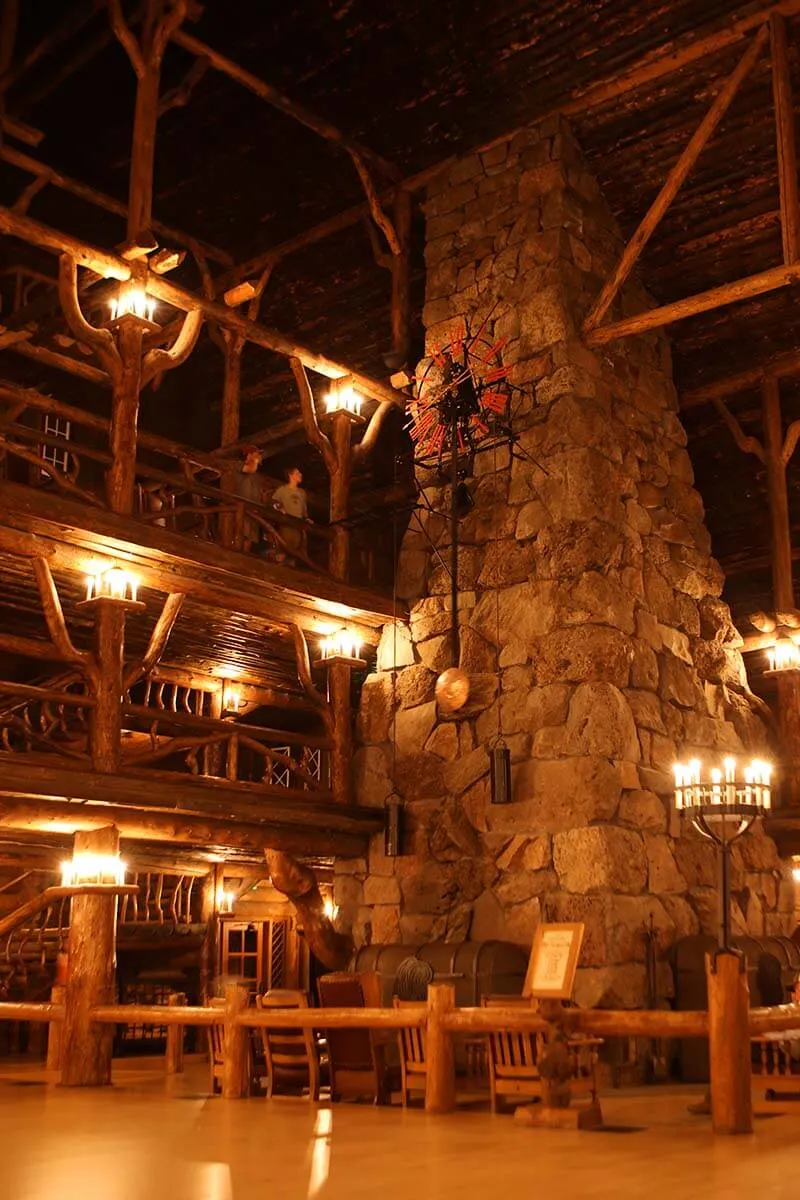
3. Morning Glory Pool (Upper Geyser Basin)
HIGHLY RECOMMENDED
Best known for the Old Faithful Geyser and the historic hotel, the Upper Geyser Basin has so much more to offer than that! In fact, this area has the largest concentration of geysers and geothermal features in the entire world. So it’s well worth planning to spend a bit more time here when touring the lower loop of Yellowstone!
While the behavior of many of the geysers in the Upper Geyser Basin area is difficult to anticipate, there are 5 geysers that are somewhat more predictable. When you visit, you’ll see the predicted eruption times for the following geysers in this area: Old Faithful Geyser, Riverside Geyser, Castle Geyser, Daisy Geyser, and Grand Geyser. And with a bit of luck, you can see one or two of them in action.
But there is more to see in this beautiful area, and it’s worth a visit either way. Be sure to walk all the way to the Morning Glory Pool. Yes, it’s a bit of a walk, but it’s totally worth it. This is one of the most colorful hot springs in Yellowstone.
Good to know: Most trails in this area are either paved roads or wooden boardwalks and are easily accessible with strollers or wheelchairs. There are lots of interconnecting walking paths and so you can easily just explore a part of the area, and make your tour as long or as short as you want.
How much time do you need: You can quickly see the main sights of the Upper Geyser Basin in about 2 hours. However, together with the Old Faithful, and depending on the predicted eruption times, and what else you choose to do here, you could easily spend half a day in the area.
LEARN MORE: Yellowstone Upper Geyser Basin
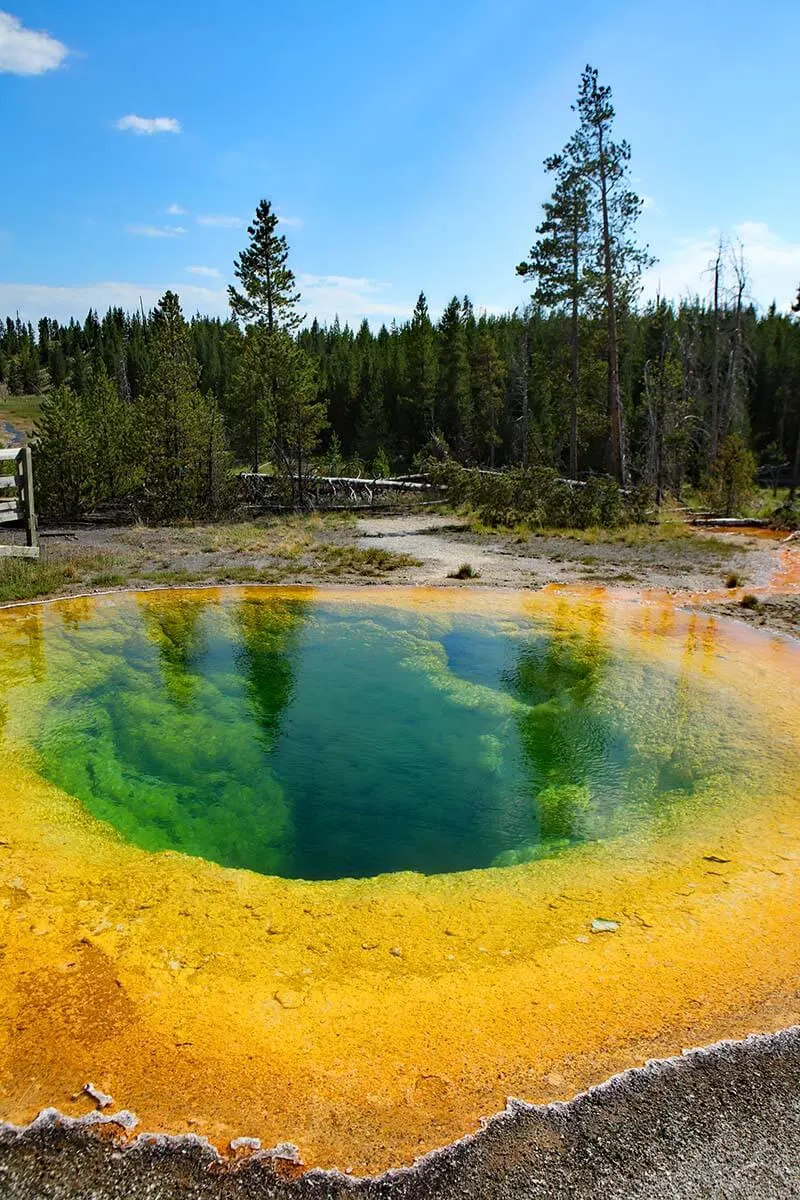
4. Black Sand Basin
NICE TO SEE
Located just near the Old Faithful area, the Black Sand Basin is incomparably quieter. You can reach it on foot from the Old Faithful (not recommended if you are short on time), or simply drive there. There’s a parking area just off the main road on the lower loop, and you can see the main sights here without having to walk far at all.
The Black Sand Basin gets its name from patches of fine black sand that were produced by the erosion of obsidian. One of the most impressive features here is a deep-blue Opalescent Pool. If you are lucky and there’s not too much steam, you can also see the Sunset Lake Pool. Emerald Pool and Rainbow Pool are also pretty.
Be sure to also wait for the Cliff Geyser to erupt. Located on the edge of Iron Spring Creek, this geyser has regular eruptions every few minutes, so you never have to wait long. Usually, it’s not as high, but sometimes the water can splash to almost 40 ft.
How much time do you need: If you come here by car, you can easily visit the area in about half an hour, maybe even less.
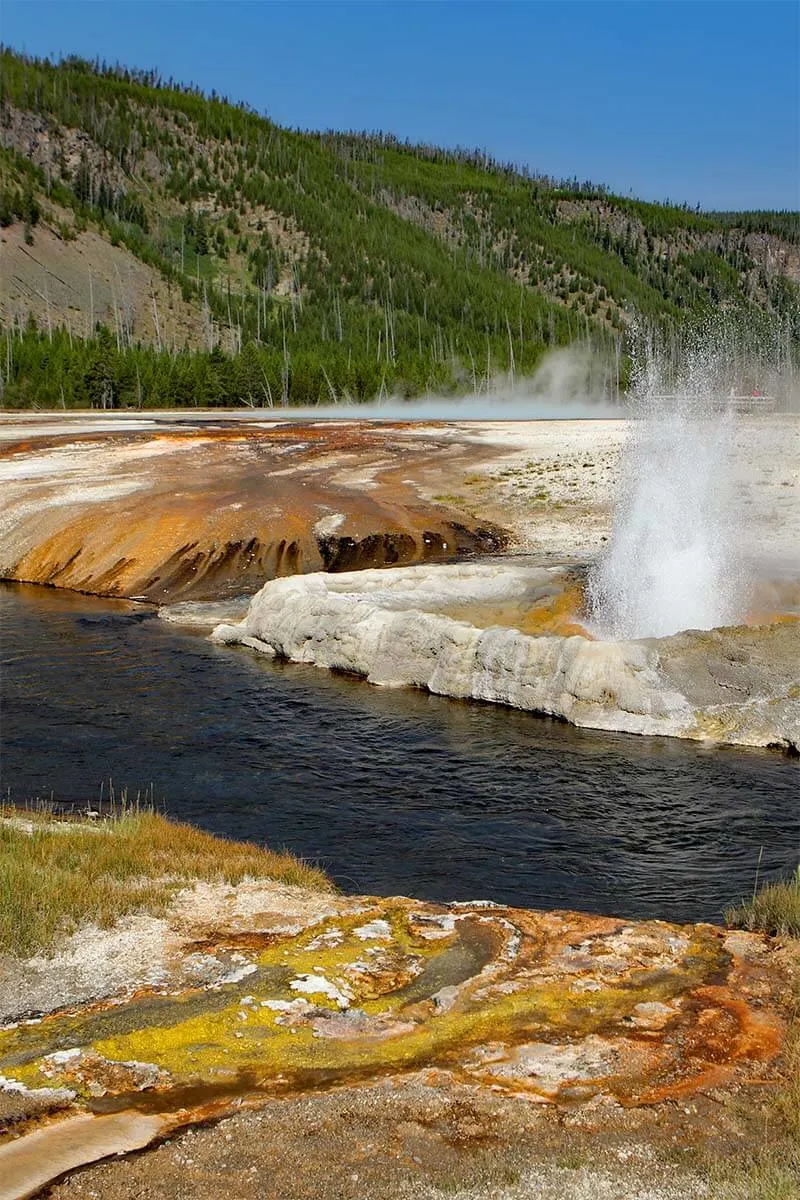
5. Biscuit Basin
NICE TO SEE
Biscuit Basin is a small geothermal area just north of the Upper Geyser Basin. It’s located right on the lower loop and can either be accessed by car or on foot from the Morning Glory Pool. Despite its proximity to the most popular attractions of Yellowstone, this area is usually not busy at all.
A short loop trail on wooden boardwalks brings you to all the main sights of Biscuit Basin. You can’t really miss the blue Sapphire Pool, the most impressive feature here. In addition, check out Black Opal Pool, Mustard Spring, and Rusty, Shell, and Jewel Geysers. A short hike to Mystic Falls also starts here.
How much time do you need: You can see the area in just half an hour or less. Count at least an hour for a visit if you also want to walk to Mystic Falls (more info below).
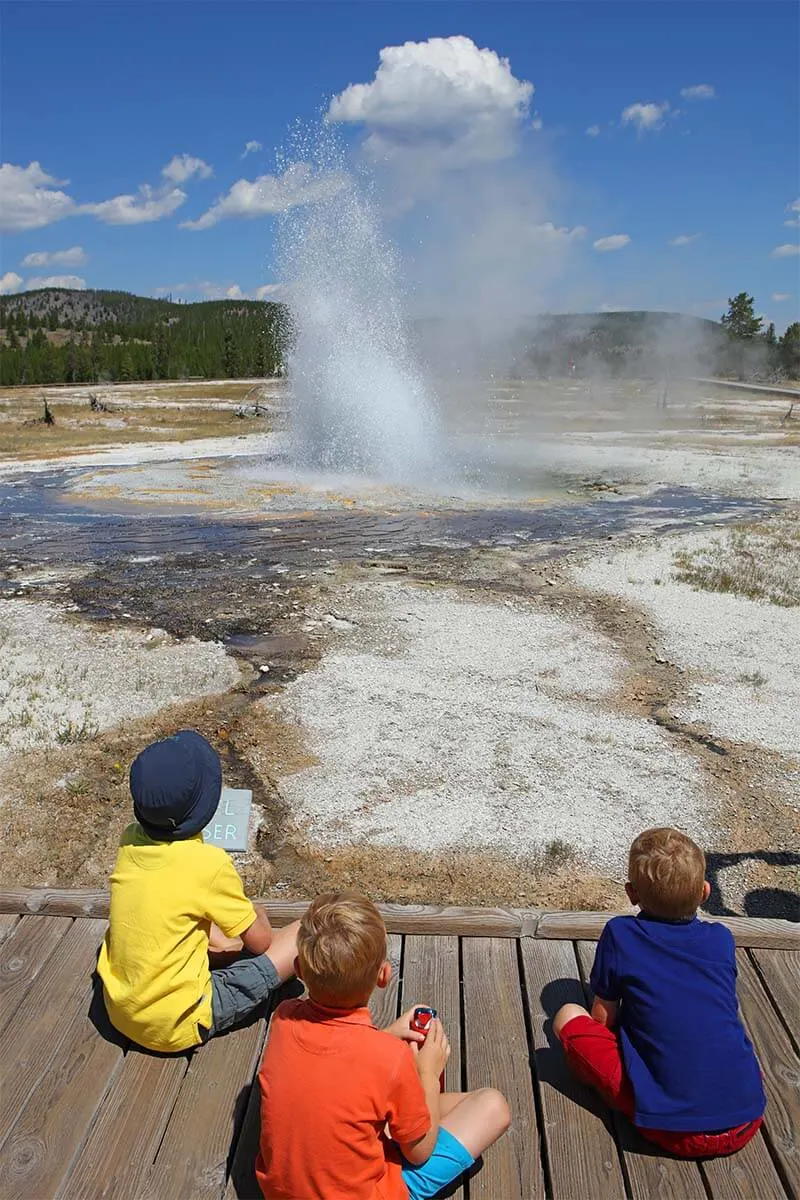
6. Mystic Falls
IF YOU HAVE MORE TIME
Mystic Falls is a nice waterfall that can be reached via a short hike that starts at Biscuit Basin. The Mystic Falls Trail is easy and the falls are just about 1-mile from the parking area (even less from the actual trailhead at the end of Biscuit Basin).
The falls are part of Little Firehole River and have a 70ft drop. There are several points from where you can enjoy the scenery, so you can decide how far you want to walk. You can just hike to the bottom of the falls or continue higher. It’s well worth going a bit further, and you’ll likely have the trail all to yourselves.
If you feel like hiking more and have a few hours to spare, you can continue to an overlook of the Upper Geyser Basin. From there, you can make a loop hike back. See here for more information.
How much time do you need: You can hike to the falls and back in about an hour. If you decide to make a loop, you’ll need at least 2 hours. If you’d walk here from the Old Faithful area (via the Upper Geyser Basin), you can spend a good part of the day exploring everything there’s to see in this part of Yellowstone.

7. Grand Prismatic Spring Overlook
HIGHLY RECOMMENDED
If you want to see the famous Grand Prismatic Spring from above, be sure to hike to the Grand Prismatic Viewing Platform. It’s accessible via the Fairy Falls Trail, which has its own parking area just next to the south loop, about 1.5 miles south of the main car parking at the Grand Prismatic Spring.
The view from here is amazing, so if you are physically capable to do this short walk, we highly recommend it. The hike up to the overlook is just a 1.2-mile round trip. The trail is a bit uneven, so good walking shoes are recommended.
Good to know: This hiking trail is open in the summer season, usually from late May. The parking here is limited, so try to arrive early in the morning or late in the afternoon.
How much time do you need: Count about 45-60 minutes for the Grand Prismatic Spring Overlook hike. This does not take into account the extra time you might need in order to find a parking spot.
TIP: If you have a few hours to spare, you may consider hiking to the Fairy Falls as well. However, this hike is much longer and will likely take you at least 2-2.5 hours. See here for more information.
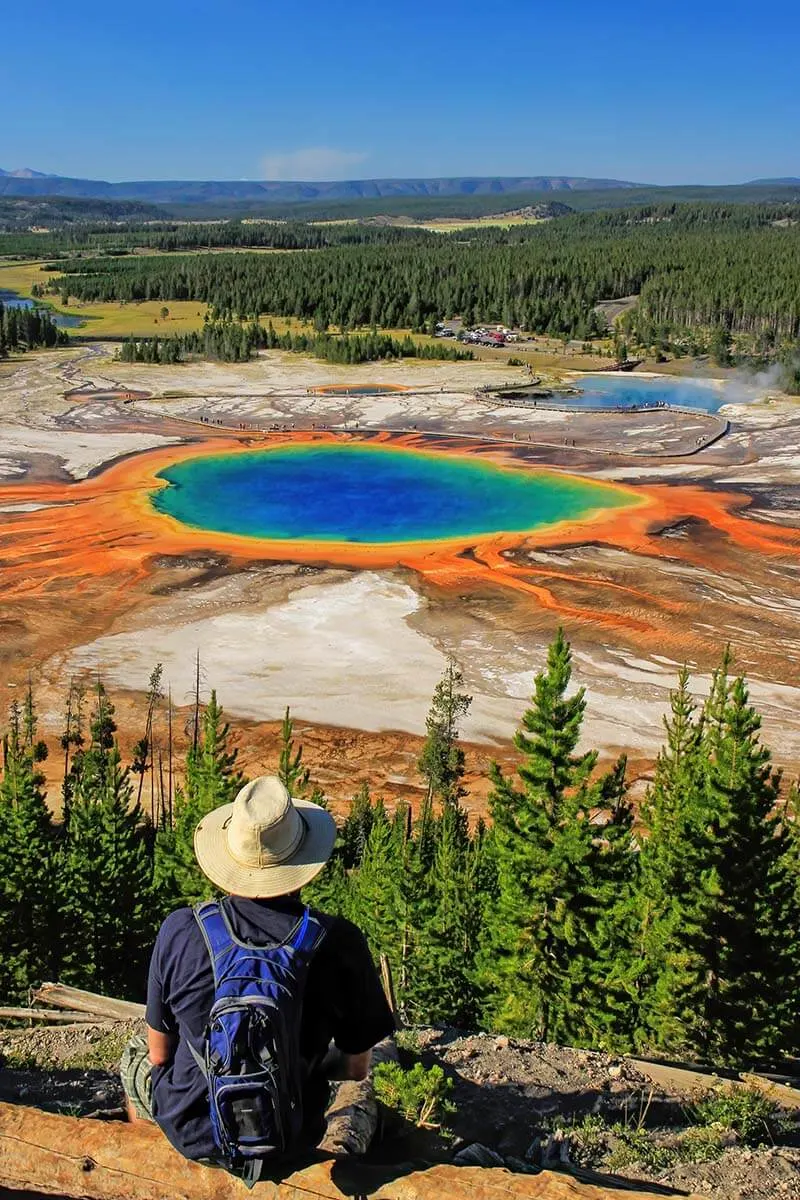
8. Grand Prismatic Spring (Midway Geyser Basin)
MUST SEE
The colorful Grand Prismatic Spring is one of the must-sees in Yellowstone. No matter how much time you have in the park, this is one of the places that should be on every Yellowstone itinerary.
Located in the Midway Geyser Basin, this is the largest hot spring in the U.S. (and the third-largest in the world). Its size and incredible colors will take your breath away! And yes, the colors can be just as vivid as in the photos, but everything depends on the light and the conditions on the day when you visit.
Good to know: The best time to see the beautiful colors of the Grand Prismatic Spring is on a sunny day. In the morning, especially if it’s colder, the spring can be a bit covered with some mist. On the other hand, it can just add to the experience. I think that this is one of those places that is always impressive, no matter the conditions.
In addition to the famous Grand Prismatic Spring, there are several other impressive geothermal features at the Midway Geyser Basin. You can’t really miss Excelsior Geyser Crater, Opal Pool, and Turquoise Pool.
The area is accessible via boardwalks so it’s simple to visit, but it’s also very busy. For fewer crowds, you may want to come here early in the morning or late in the evening. For the best colors, however, come here in the middle of the day.
How much time do you need: You’ll likely need at least 1 hour for a visit to the Grand Prismatic Spring. That’s if you are lucky to find a parking spot without a long wait. Otherwise, you might need up to 2 hours.
LEARN MORE: Grand Prismatic Spring: Complete Guide
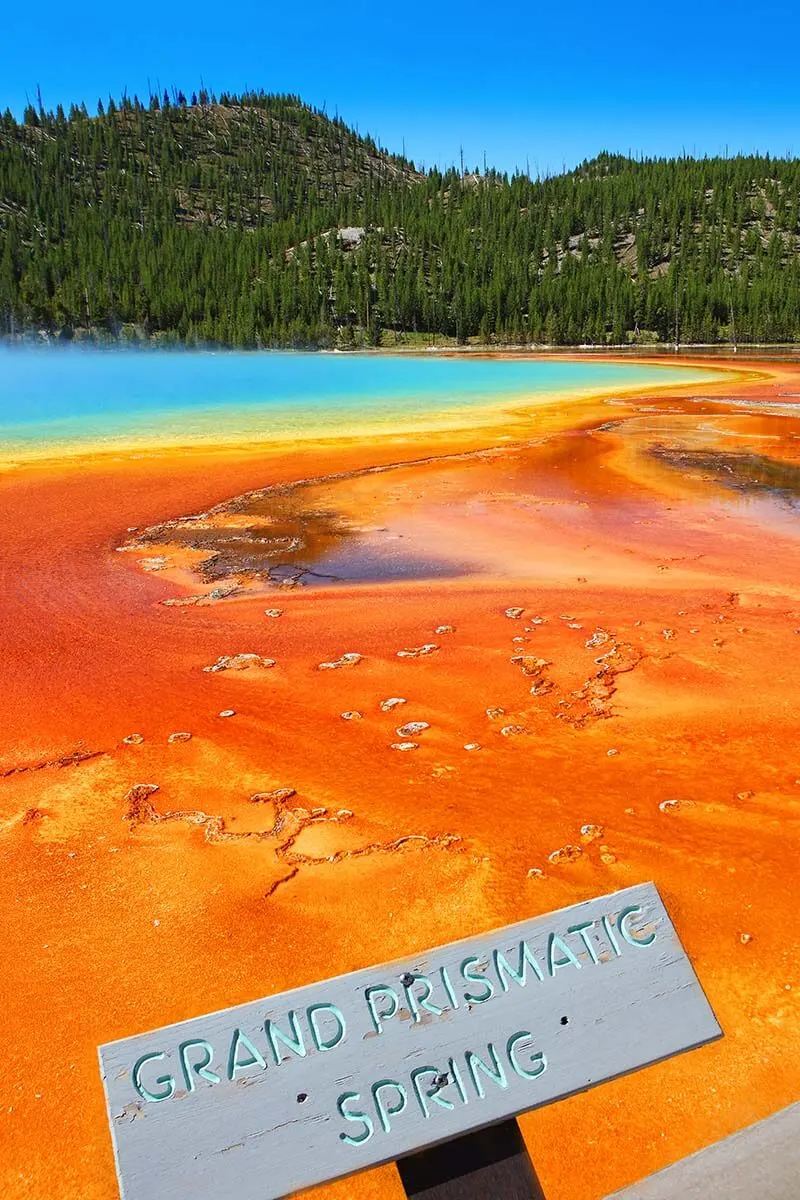
9. Firehole Lake Drive
IF YOU HAVE MORE TIME
Firehole Lake Drive is a small detour from the main road of the Yellowstone South Loop. This is a one-way 3-mile drive that passes through yet another geothermal area. You can see some geysers and hot springs from the road, but if you have more time, it’s best to stop at a few places and see some of the geothermal features from close by.
Some of the nicest places to see here include the Firehole Spring and Surprise Pool. You may also get lucky and get to see some geysers in action.
One of the main attractions in this area is the Great Fountain Geyser. It sprouts water over 100 ft in the air (and sometimes even much higher), and an eruption can take up to an hour. However, its intervals are around 10 hours (give or take a few hours), so it’s not really something you can easily plan for.
Much easier to see (but also much smaller) is the White Dome Geyser with regular short eruptions, sometimes as frequent as 15-20 minutes.
How much time do you need: You can just drive by in a few minutes, visit the area in half an hour, or spend a few hours waiting to see some geysers in action.
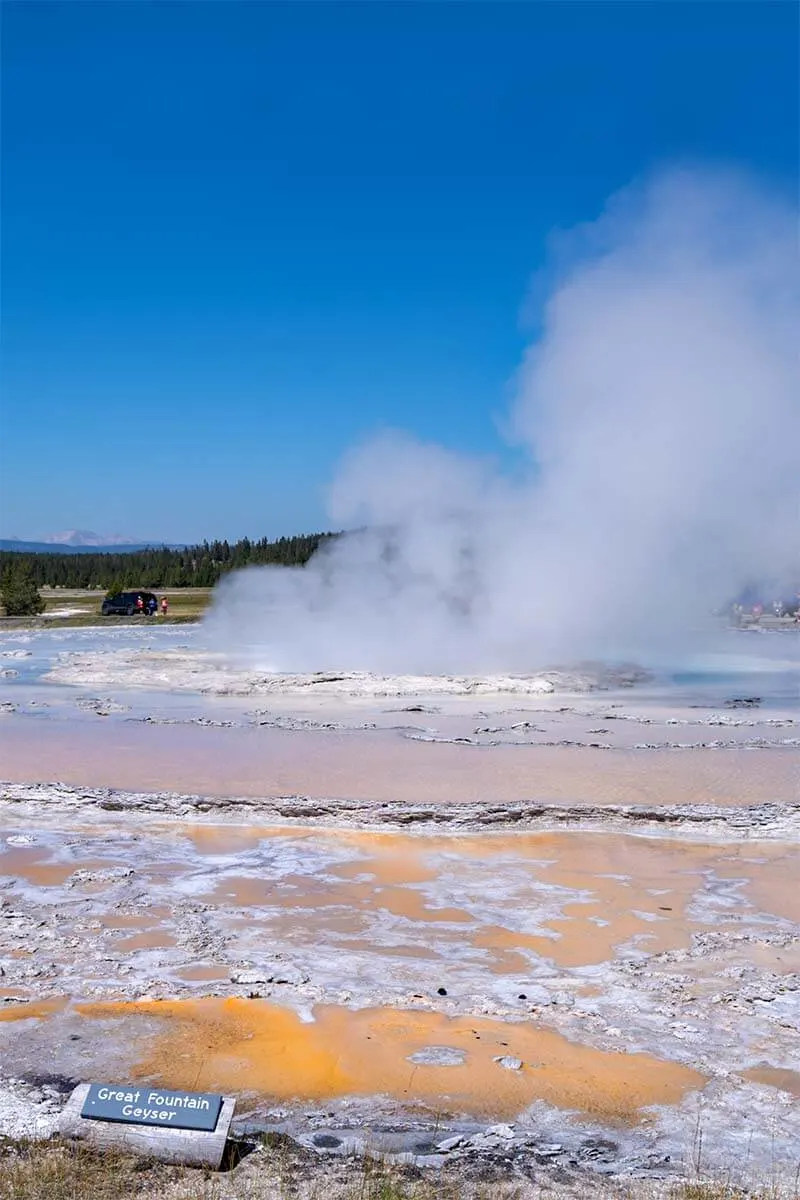
10. Fountain Paint Pots (Lower Geyser Basin)
IF YOU HAVE MORE TIME
Fountain Paint Pots are located in the Lower Geyser Basin along the western side of the south loop, 2 miles north of Grand Prismatic. This is one of the smaller and less-visited geothermal areas in Yellowstone. It’s not a must-see, but it can be a nice addition to your lower loop itinerary if you have some extra time to explore deeper.
In addition to the Fountain Paint Pot itself (which is a mud pool), there are a few other geothermal pools, hot springs, and several active geysers in this area as well. Some of the nicest features include Celestine Pool, Silex Spring, and Leather Pool.
You can see all the places by following a short loop trail. It’s all boardwalks, so the area is accessible, but there is a steeper section and a few steps at one of the geysers.
How much time do you need: You can see this area in 15-30 minutes.
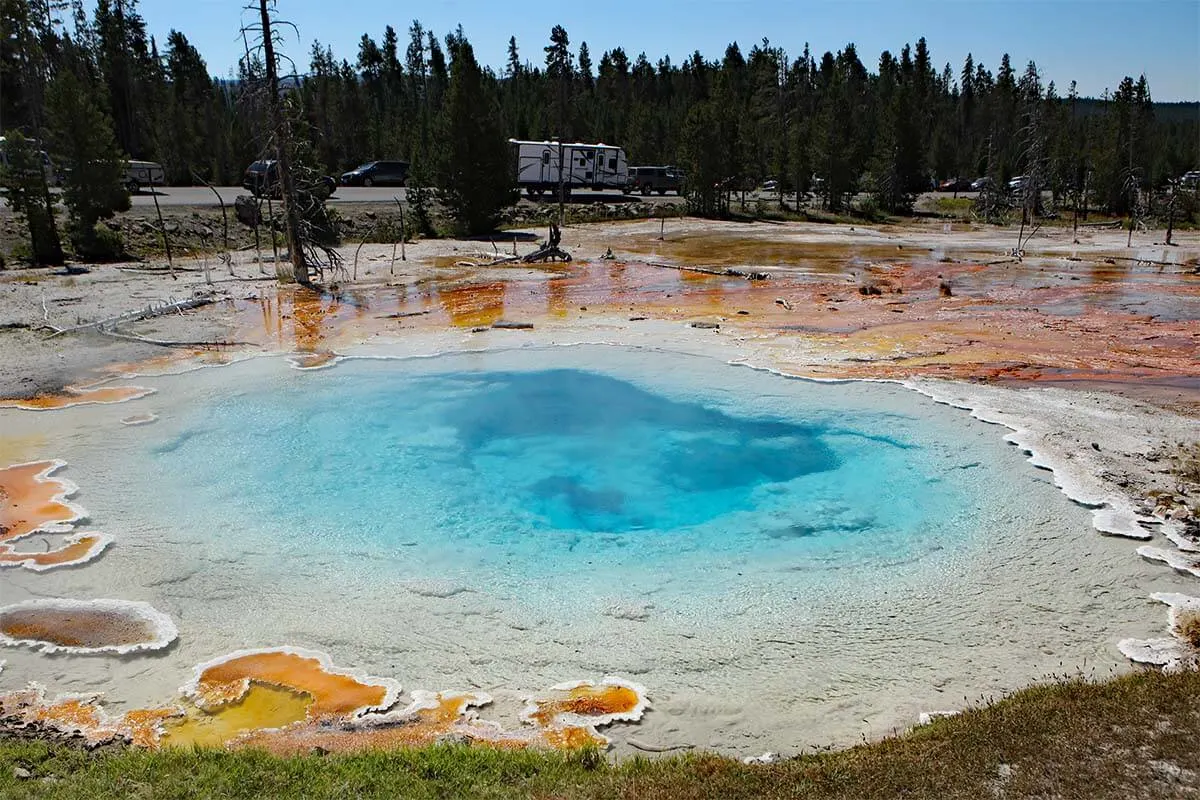
11. Firehole Canyon Road & Firehole River Swimming Area
IF YOU HAVE MORE TIME
Firehole Canyon Road is a scenic drive about 2 miles south of Madison Junction. It’s a small detour off the main lower loop road, and you can only drive this road one way starting from the northern end.
There are several places to see here – Firehole Falls and the Firehole River Swim Area, one of the two swimming areas in Yellowstone (the other one is Boiling River on the north side of the park).
If you are visiting Yellowstone in the late summer and the weather is nice, this can be a great place to spend a couple of hours. However, you may want to arrive here very early in the morning, and especially if you want to go swimming, or you risk not being able to find a parking spot. When the area is actually open for swimming, this road can get really crowded and you’ll see vehicles parked all over the place.
Good to know: Be sure to check the official website for up-to-date information and current conditions. Most years, this area only opens for swimming from about mid-summer. And in some years when the runoff is too strong and the water levels are too high, you can’t swim here at all.
But even if you can’t go swimming, this road is well worth a short detour. If you can find a parking spot, be sure to visit the Firehole Falls. The walk from the road to the falls is really short and it’s totally worth it. This is one of the hidden gems just off the south loop in Yellowstone.
How much time do you need: You can just drive this road without stopping in a few minutes. The rest really depends on how busy it is and whether you can go swimming. If you just visit the falls, you’ll likely need 20-30 minutes. And if you can go swimming, you could easily spend several hours here.
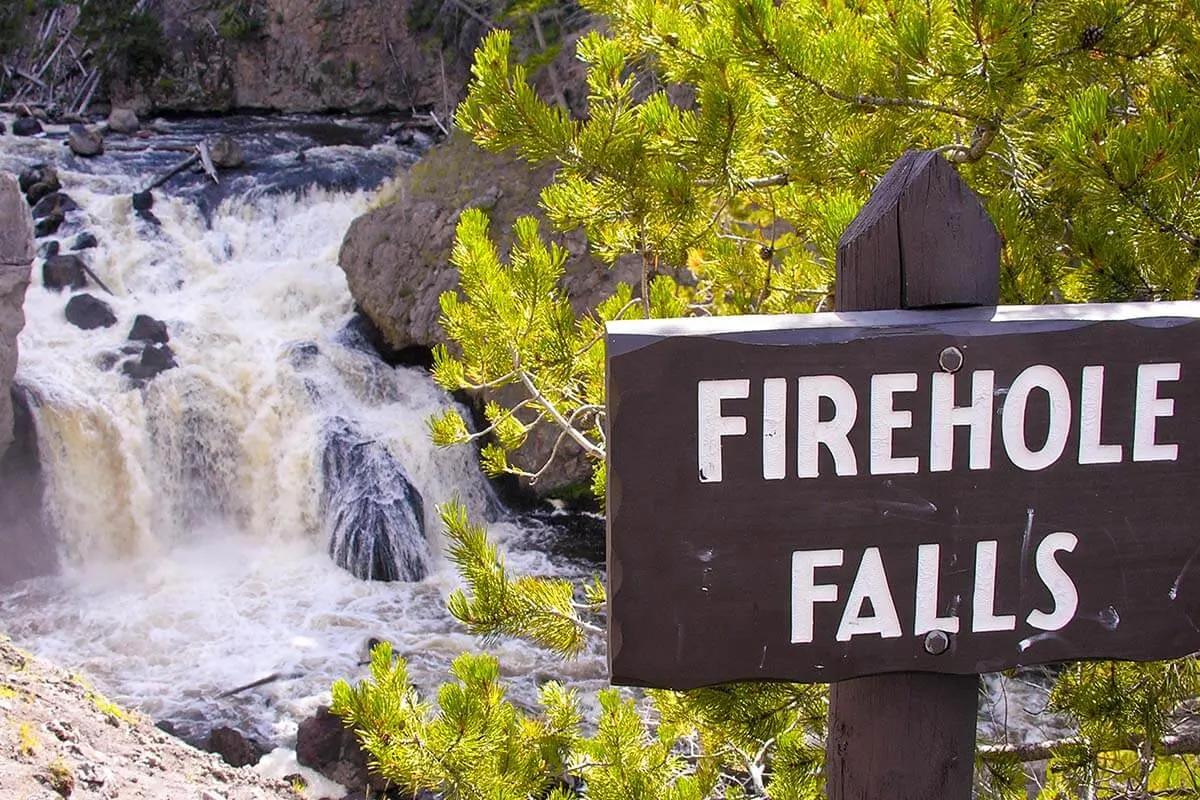
12. Gibbon Falls
NICE TO SEE
Gibbon Falls is a nice waterfall along the middle section of Yellowstone’s grand loop. It’s located about 5 miles east of Madison Junction, just next to the road towards Yellowstone Canyon.
There’s a small car parking area from where you can walk to the waterfall. The paved trail is easy and the furthest point is just 0.5 miles round trip. Be sure to walk all the way to the end – you get to see different angles of the waterfall.
How much time do you need: A visit here only takes a few minutes of your time. However, finding a parking spot can take longer than actually visiting the falls. But since the walk is short, people are coming and going all the time, so normally you won’t have to wait very long.
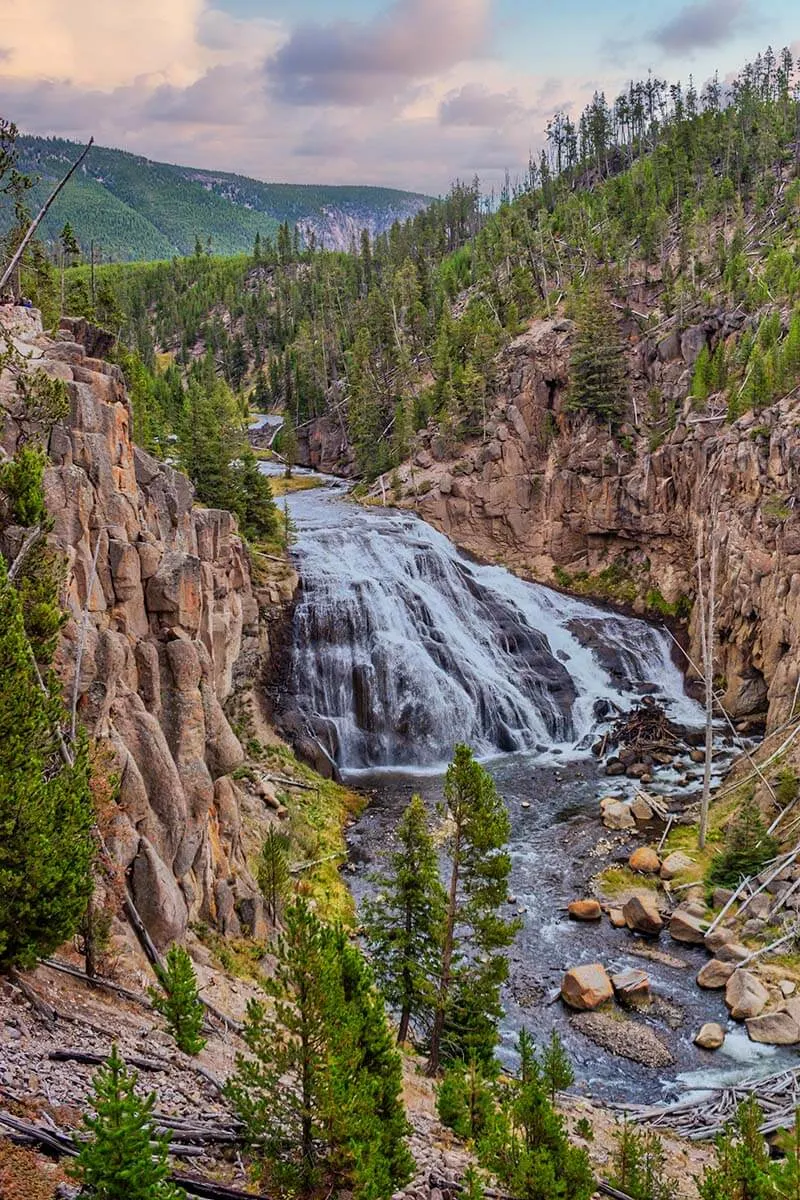
13. Artist Paintpots
NICE TO SEE
Artist Paintpots is a geothermal area located on the upper west side of Yellowstone’s south loop, about 10 miles northeast of Madison Junction.
Despite its convenient location just next to the main loop road, it’s not nearly as popular as most other places on this list. I guess the reason is quite simple – with so many geothermal features all over Yellowstone, it’s easy to get geyser-tired after a while. Still, if you have some time to spare and want to stretch your legs a bit, this can be a nice stop to consider when driving the lower loop of Yellowstone.
This area also has boardwalks, but part of it is located on the hill, so you’ll have to do some stairs. But it’s a really easy walk and the views from the upper part are quite nice. You can see the colorful mud pools, fumaroles, and other geothermal features below, and far views of the park in the distance.
How much time do you need: If you choose to walk the entire loop, it’s about 1.5 miles and will likely take you 30-45 minutes.

14. Norris Geyser Basin
NICE TO SEE
Norris Geyser Basin is the hottest geyser basin of Yellowstone National Park. This area is also quite big and is comprised of two very different sections – Porcelain Basin and the Back Basin. You can also take a look inside Norris Geyser Basin Museum.
The landscape of Porcelain Basin is rather barren with steaming vents, colorful hot springs, and lots of bubbling and boiling geothermal features. Whereas Back Basin is in the forest and you’ll be walking between trees. There are a few geysers here and you might get lucky and see some of them in action.
The main attraction of the Back Basin is Steamboat Geyser, which is the tallest active geyser in the world. It has been known to sprout water up to 300ft (90m) in the air, but this type of eruption is rare and unpredictable. It has frequent minor eruptions of 10-40 ft, so you’ll always see some action here.
How much time do you need: You can spend just an hour here and see some of the highlights in one of the two areas. You’ll probably need at least 2-3 hours to properly explore both parts of Norris Geyser Basin.
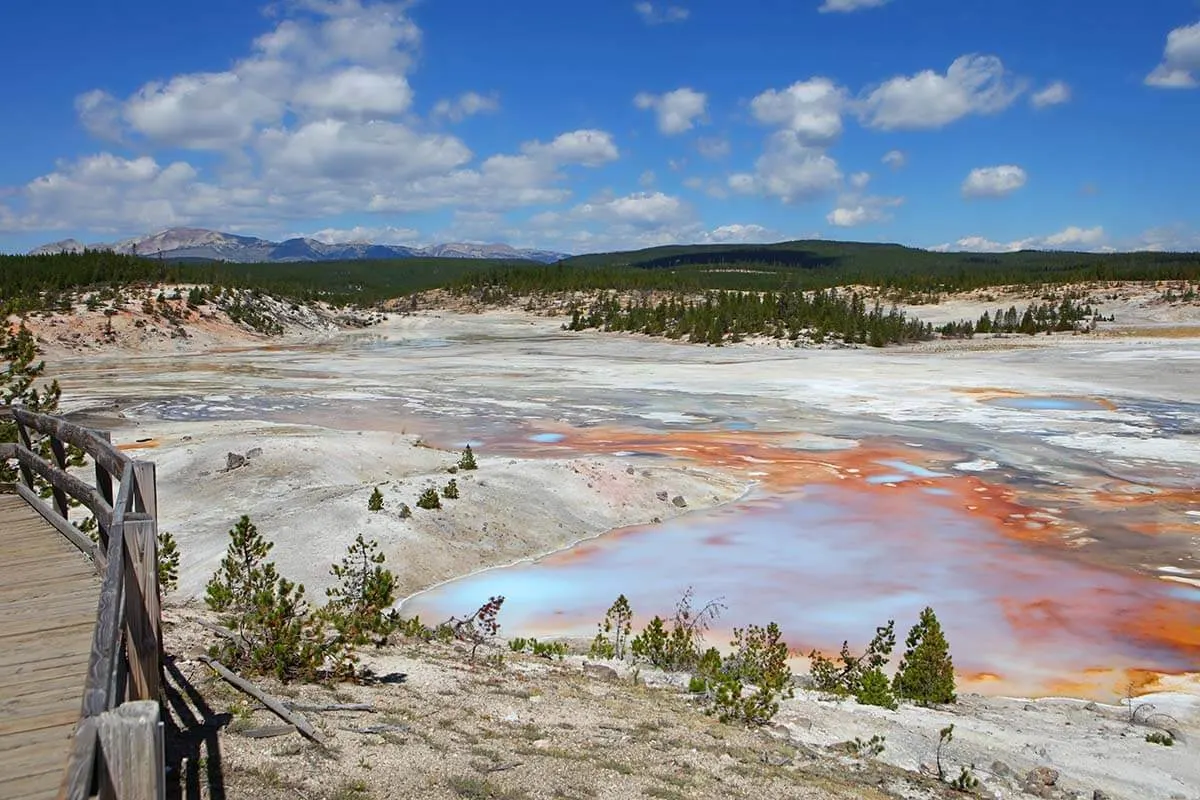
15. Virginia Cascade Drive
IF YOU HAVE MORE TIME
Virginia Cascade Drive is a 2-mile one-way drive just next to the Norris Canyon Road (the upper part of Yellowstone’s south loop). The road follows Gibbon River and at one point you can also see the falling water of Virginia Cascade.
There’s not that much to see here, so this is one of the quietest places to visit in the area. The chances are high you’ll hardly see anyone around, but that’s also what makes it a nice short detour. You may get lucky and spot some wildlife here too.
Good to know: Towards the end of the drive, you’ll find is a beautiful meadow and a couple of picnic tables. This could be a nice quiet place for a picnic lunch.
How much time do you need: You can just drive by here in a few minutes.
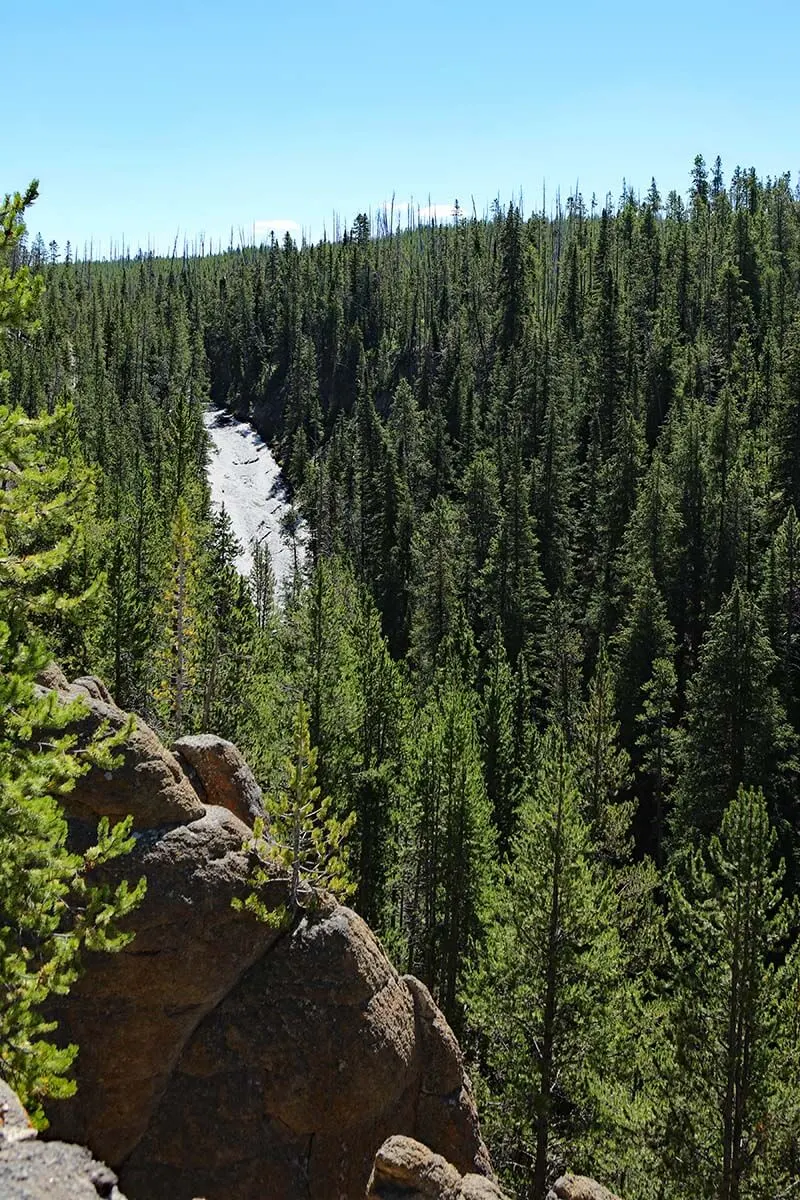
16. Ice Lake
IF YOU HAVE MORE TIME
Ice Lake is a small picturesque lake located rather close to the main road between Norris Junction and Canyon Village.
This is something nice to do if you have plenty of time and want to get off the beaten track. However, the trail isn’t really well maintained and it’s difficult to find good access to the lake. All in all, we enjoyed a quick stop here, but it’s definitely not a must.
How much time do you need: It really depends on how far you decide to walk. You can walk to the lake in just a few minutes, or you can also wander a bit further and look if you can get somewhat closer to the water. We spent some 20-30 minutes here.
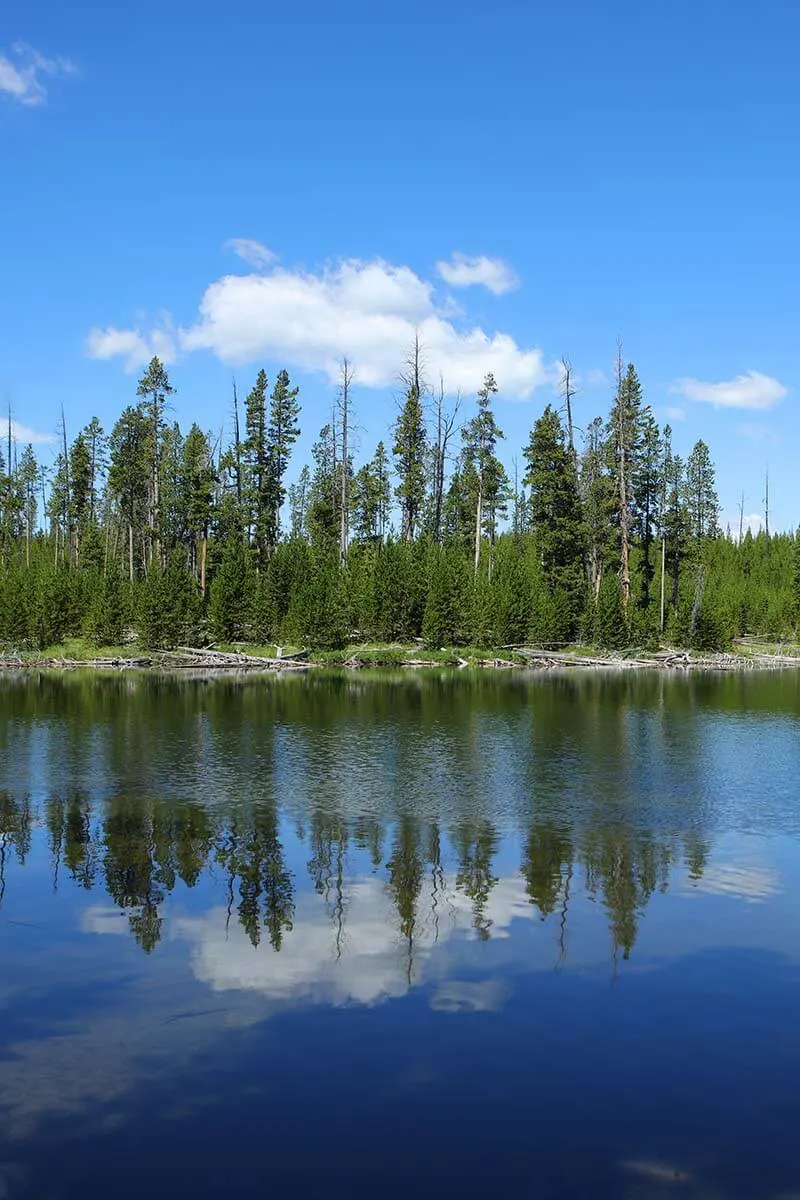
17. Grand Canyon of the Yellowstone
MUST-SEE
The Grand Canyon of the Yellowstone River is another must-see in Yellowstone. However, a visit here is not as straightforward as in the other areas since this area is so big and there is a lot to see.
Most visitors just head to the Artist Point, which is the best known viewpoint of the Yellowstone Canyon. But there are so many other beautiful spots where you can enjoy spectacular views of the canyon and the waterfalls.
The nicest viewpoints include the Brink of the Upper Falls, Brink of the Lower Falls, Inspiration Point, Lookout Point, and Grand View. All of these can be easily accessed from the road, but several viewpoints involve quite a few stairs.
In addition to many viewpoints on both sides of the canyon rim, there are also lots of hiking trails here. If you have more time, consider a longer hike here.
TIP: If you can spare half a day, you can join this highly-rated hiking tour here. It’s a great way to see some of the nicest landscapes of the Yellowstone Canyon, and hiking in a group is always safer than on your own (otherwise, be sure to pack a bear spray).
How much time do you need: You can just visit Artist Point in 15-20 minutes, some of the best viewpoints in 1-2 hours, or you can spend an entire day here. See our detailed guide below for more information on what to see and do at Yellowstone Canyon.
LEARN MORE: Yellowstone Canyon: Complete Guide & Map
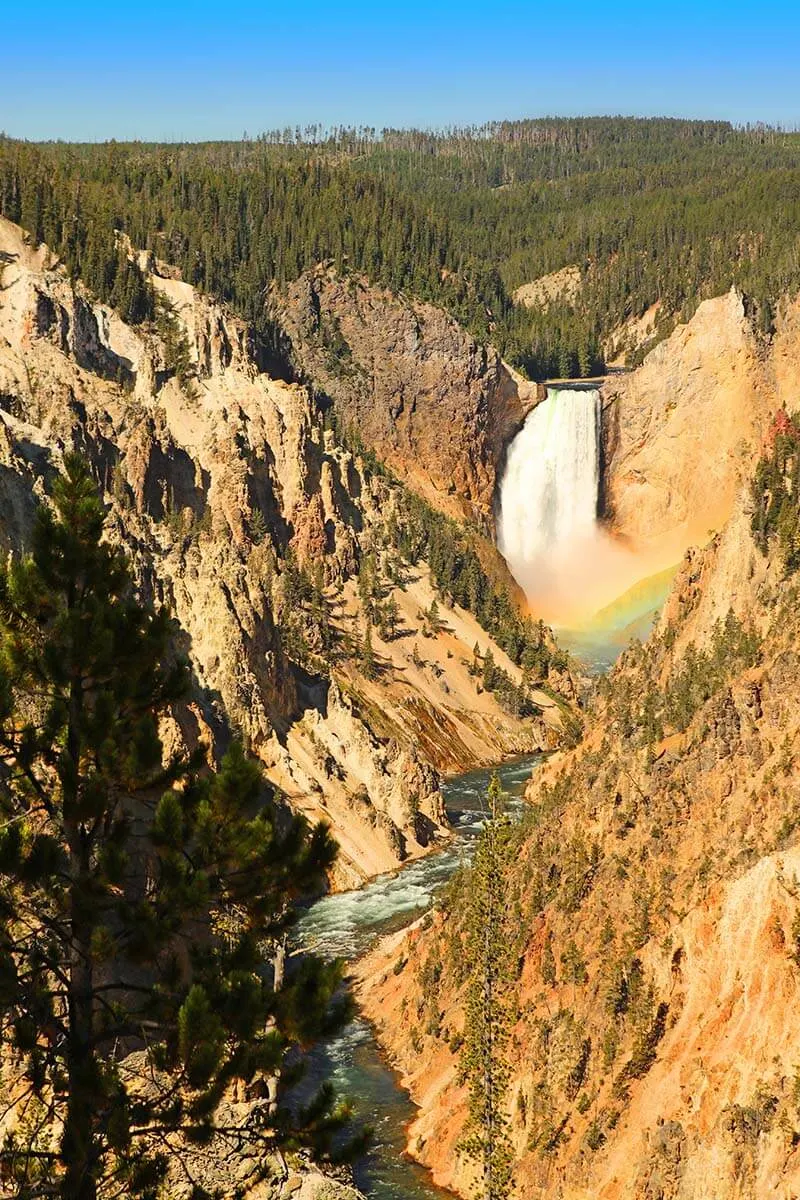
18. Hayden Valley
MUST-SEE
Hayden Valley is one of the best places to see wildlife in Yellowstone (another one is Lamar Valley in the north). The south loop of Yellowstone divides this valley in two, which means that there are animals crossing the road here all the time. Most of the time, it’s bison, but you may get lucky to see some bears or elk here as well.
No matter when you visit, be prepared for some major bison traffic jams when driving through here! Sometimes, park rangers have to interfere and try to get bison to move away from the road. It’s fun to watch.
Good to know: There are many pull-offs along the road where you can park your car and watch wildlife. And if the traffic is really slow, you can watch animals as you drive. If you pull off, stay close to your car and never get too close to the animals!
TIP: Try not to get upset about slow traffic and just enjoy the scenery! Often, you can see bison really close to the road. It’s a wonderful opportunity to watch these animals from the safety of your car.
How much time do you need: The distance between Canyon Village and Yellowstone Lake is about 20 miles and normally takes about 30 minutes. However, if there are lots of bison around, the drive through Hayden Valley can take up to 1-1.5 hours.
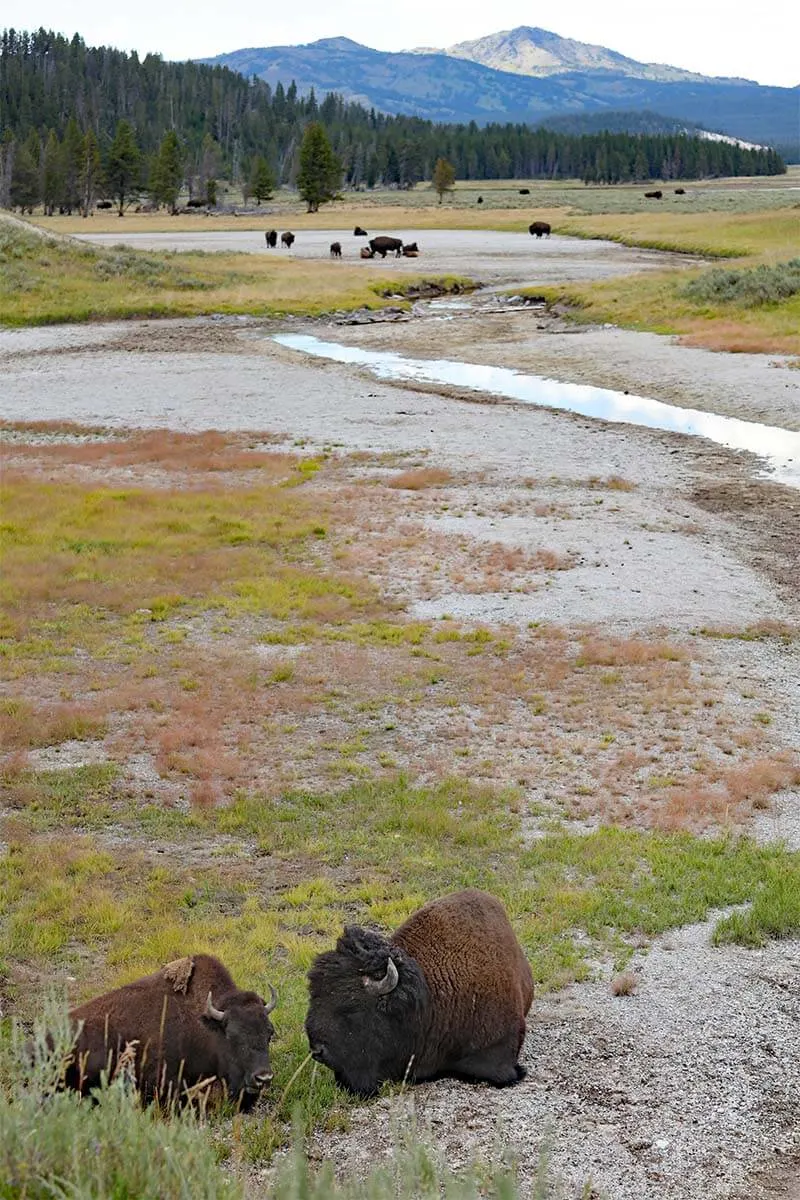
19. Mud Volcano & Dragon’s Mouth Spring
NICE TO SEE
Mud Volcano area is located between Hayden Valley and Yellowstone Lake. It’s quite a popular stop along Yellowstone’s south loop.
There are lots of smaller geothermal features here, mainly sprouting mud pools. The most impressive is Dragon’s Mouth Spring. As hot steam emerges from a small cave, you can hear a steaming and roaring sound. This sound gave name to this place, but no worries – there are no dragons here. You may get lucky and see some bison though.
Also here, you can explore the area via a series of boardwalks. Some other notable features here include Grizzly Fumarole, Black Dragons Caldron, Churning Caldron, Mud Caldron, and Sizzling Basin.
How much time do you need: Depending on what you want to see, plan 10-30 minutes here.
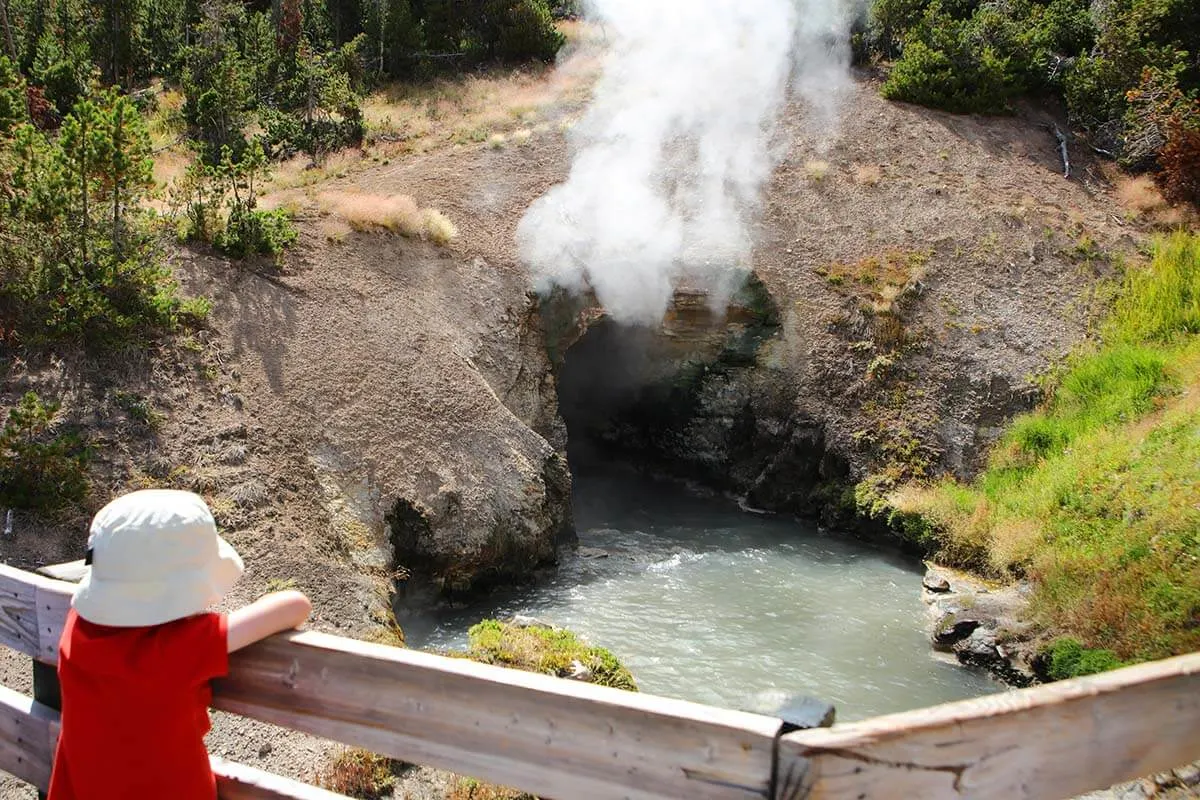
20. Fishing Bridge
IF YOU HAVE MORE TIME
Fishing Bridge stands at the intersection of Yellowstone River and Yellowstone Lake. This used to be a major spawning area for trout and the most popular place to fish in Yellowstone. Thus the name.
Due to a big decline in the trout population, fishing here has been forbidden since the 70s, but it remains a popular place to watch fish.
This wooden bridge dates from 1937 and is a rather interesting construction. So it can be a nice place to see in itself. You can walk on the bridge (it has a pedestrian section on both sides) or you can see it from a distance.
How much time do you need: It really depends on what you plan to do. You can just drive over the bridge, or you can park the car at the nearby Fishing Bridge Visitor Center and explore the area a bit longer.
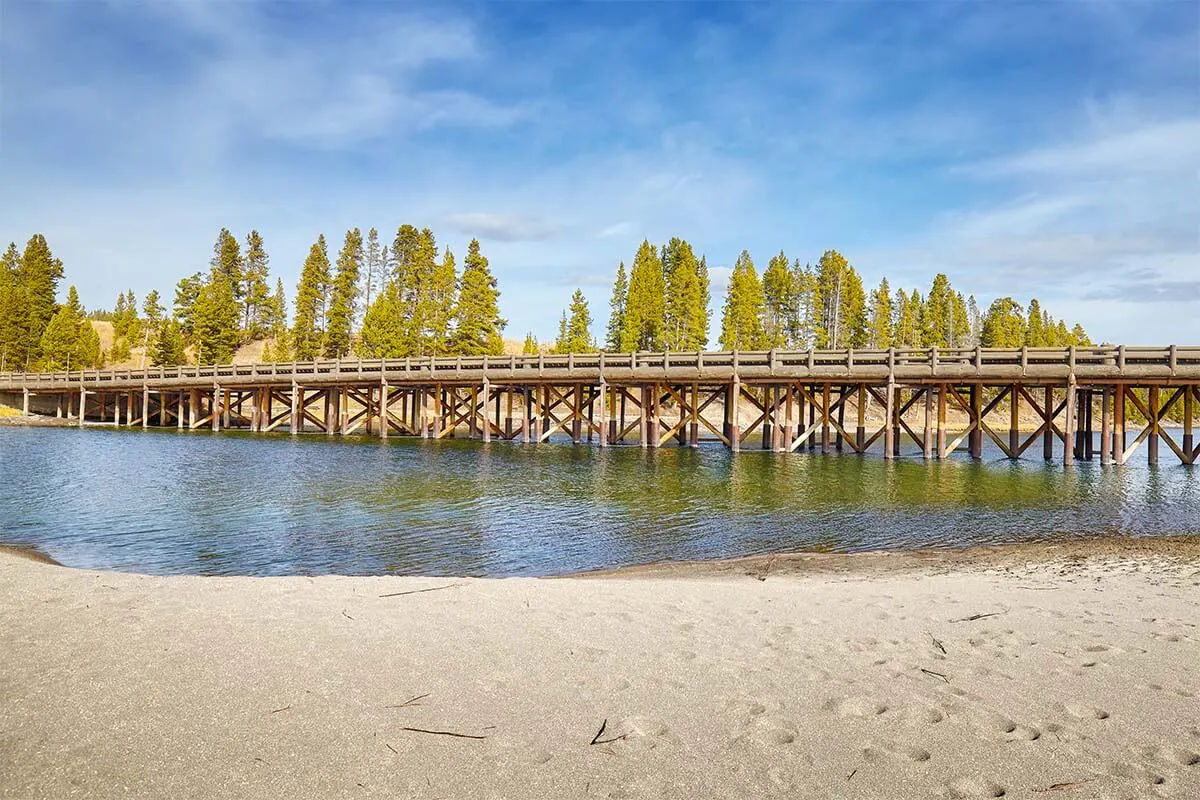
21. Storm Point Hike
IF YOU HAVE MORE TIME
Storm Point hike is one of the best easy short hikes in Yellowstone. The trail brings you to Storm Point on the northern end of Yellowstone Lake. The scenery here is really nice and the area is quite picturesque.
You start the hike at Indian Pond and walk through the green meadows, through a forest, and onto the sandy lakeshore. You then walk a bit next to the lake before making a loop back towards the car parking area.
Located about 3 miles east of the Fishing Bridge, Storm Point is technically not part of the south loop of Yellowstone. However, it’s such a tiny detour that we feel obliged to mention it here. We really enjoyed this short walk and we saw more elk here than people.
How much time do you need: Storm Point hike is an easy 2.7-mile loop trail that takes about an hour. You can find more information about this trail here.
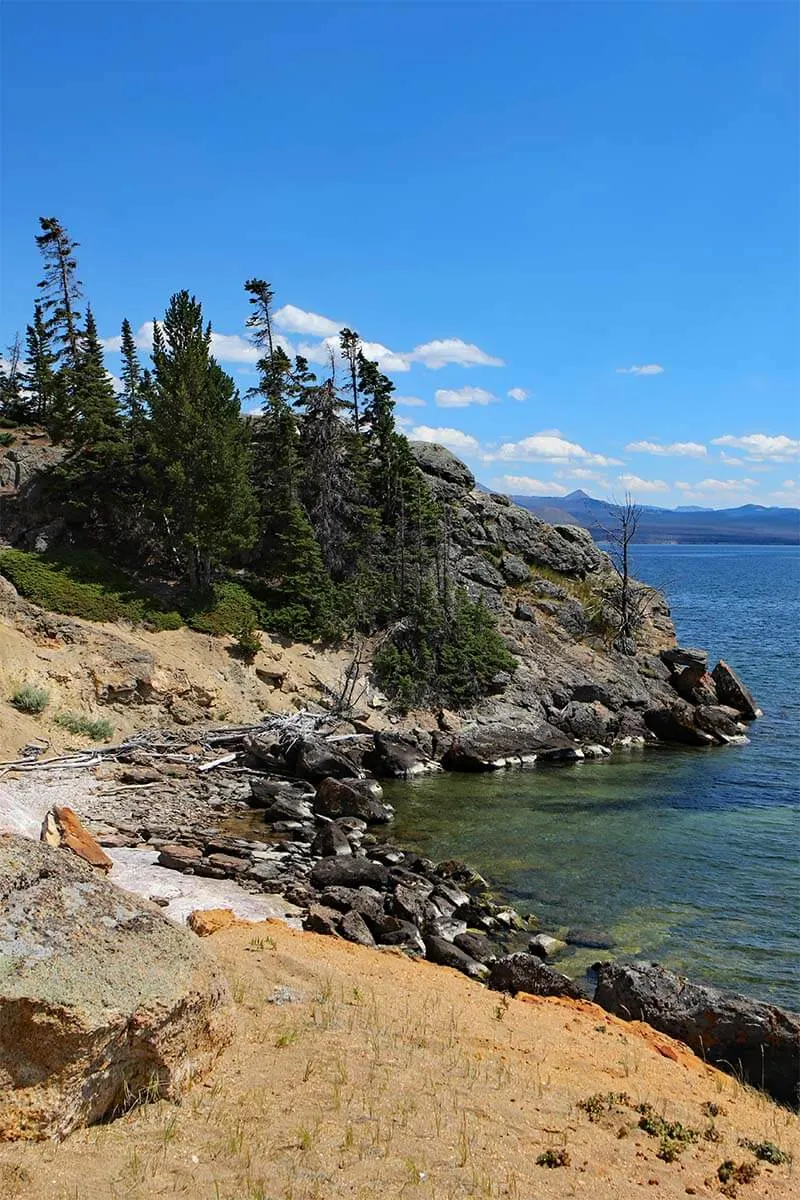
22. Yellowstone Lake: Village & Boat Tours
HIGHLY RECOMMENDED
Yellowstone Lake is one of the top places to see in Yellowstone. It’s huge and several of the other attractions mentioned in this article will bring you close to the lake affording nice views of the surroundings. So you don’t absolutely have to plan extra time to ‘visit’ the lake.
However, if you do have some time to spare, it’s well worth stopping by the historic Lake Lodge and exploring the area a bit more. Alternatively, you can also head to Bridge Bay Marina where you can rent a boat and explore the lake. Keep in mind that boat rentals are available by the hour, and are first-come-first-served (more info on boat rentals here).
Yellowstone Lake scenic cruises also depart from Bridge Bay Marina. They take 1 hour and can be booked in advance (more info here).
TIP: One of the nicest ways to enjoy the beautiful Yellowstone Lake is by going kayaking. There are various kayaking tours available, from 2 to 6 hours. Just be sure to book in advance!
How much time do you need: You can just see the lake from the road, visit the Lake Village for an hour or so, or spend half a day in this area. It all depends on what you choose to see and do here.
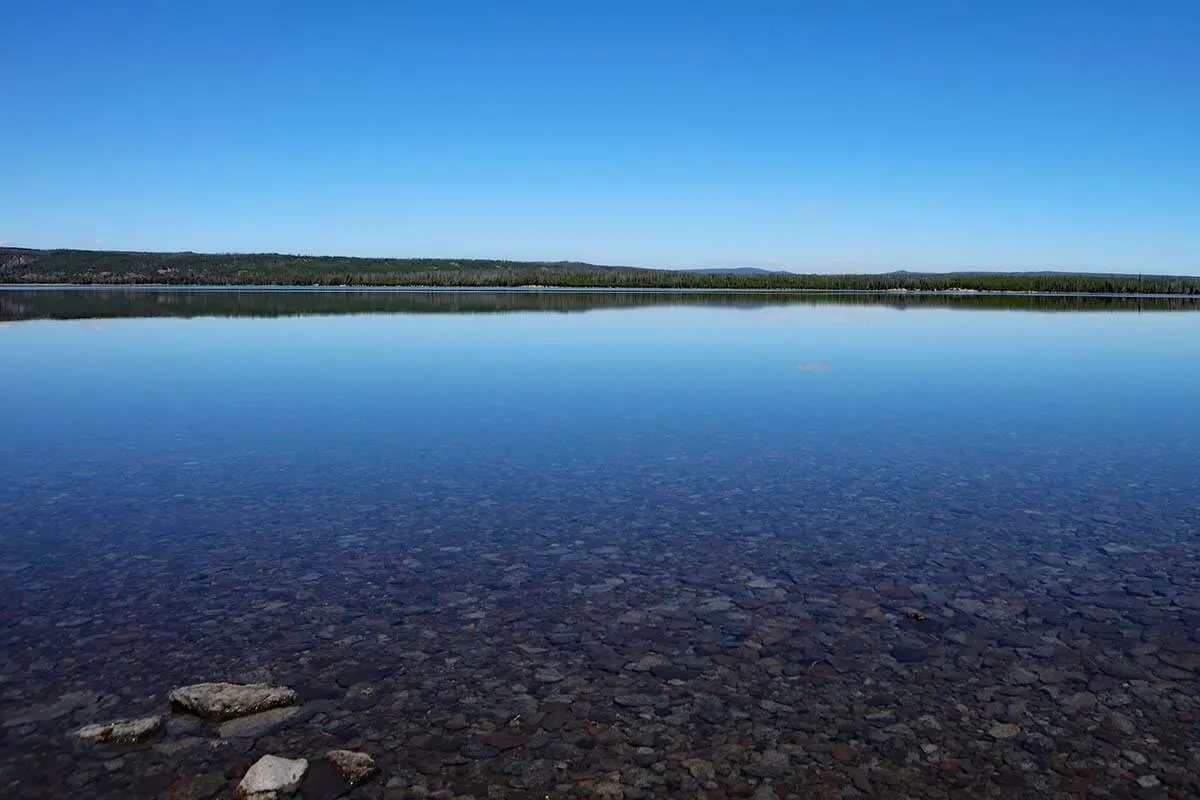
23. Natural Bridge Yellowstone
IF YOU HAVE MORE TIME
Natural Bridge is one of the lesser-known places that you can visit just off the south loop in Yellowstone. It’s an easy, 1-mile walk to get here, and there’s even a paved bike trail to the base of the bridge. It’s usually not busy here at all.
You can see the bridge from the base, but there’s also a steeper trail to the top that’s worth the short climb. From the upper angle, you can look through the hole back towards the trail that you took to get here. Just keep in mind that crossing this natural bridge is forbidden!
How much time do you need: Count about 1 hour for a visit here.

24. West Thumb Geyser Basin
MUST-SEE
Located on the southernmost point of Yellowstone’s lower loop, West Thumb Geyser Basin is a very colorful geothermal area. What makes it even more special is that it’s right next to Yellowstone Lake, so the scenery here is really nice.
In addition, this area is quite compact and doesn’t require that much time to visit. So do not miss it!
There are lots of colorful hot springs here; too many to even mention. But don’t worry – you can see everything by simply following a loop trail on well-maintained boardwalks.
How much time do you need: Count 30-45 minutes for a visit here.
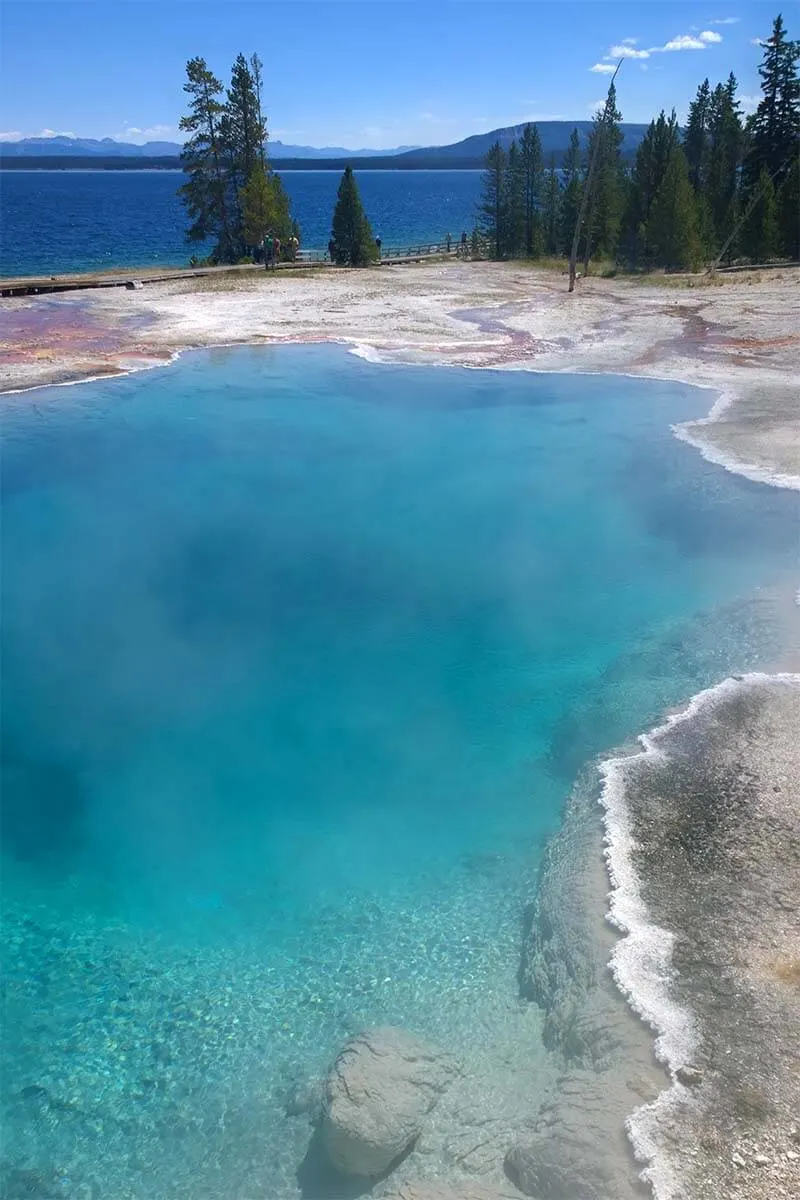
25. Continental Divide at Craig Pass and Isa Lake
NICE TO SEE
Yellowstone is located on the Continental Divide and there are several places where you can see the signs marking this. One of the best spots to stop for a picture of the ‘Continental Divide’ sign is Craig Pass, right on the south loop of Yellowstone.
There is also a small lake here, Isa Lake, and you may get lucky to see yellow pond lilies in bloom on the lake.
How much time do you need: This is just a short photo stop, 5-10 minutes.
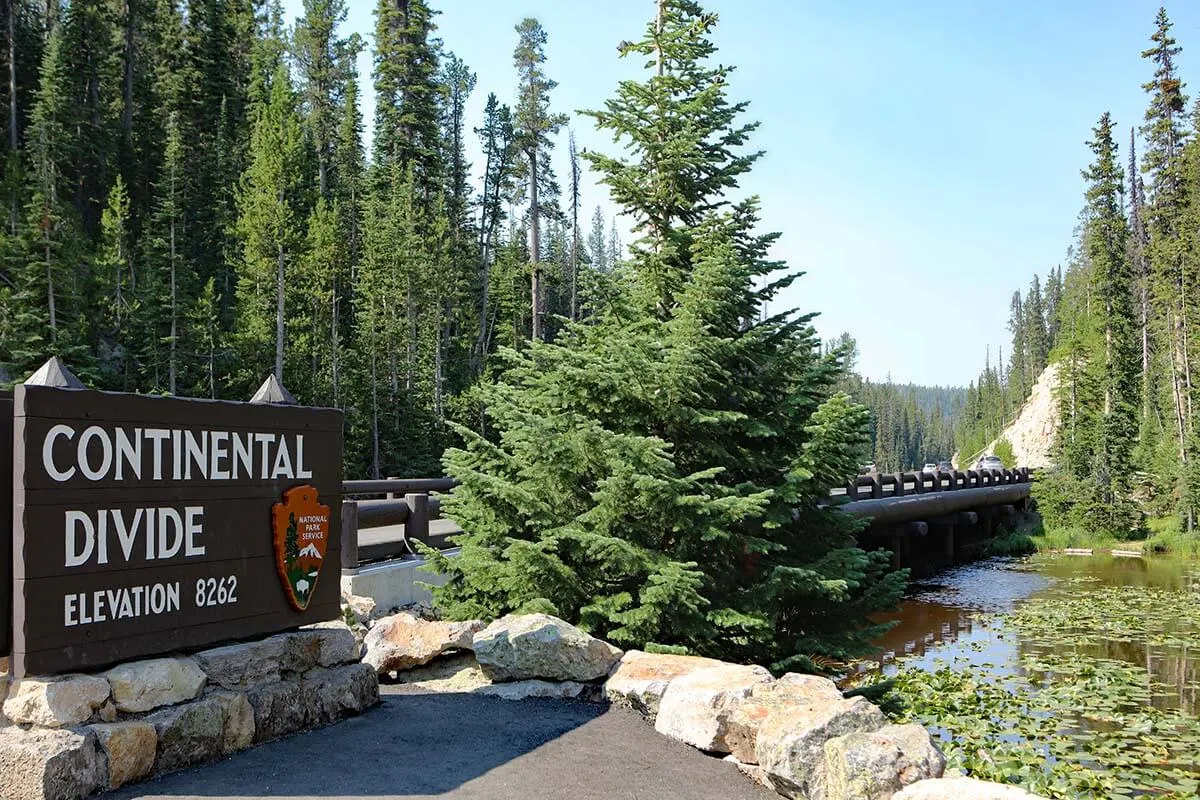
26. Kepler Cascades
IF YOU HAVE MORE TIME
Kepler Cascades is a nice waterfall of the Firehole River. It’s located just south of the Old Faithful area and has its own car parking. From the car, it’s just a very short walk to the viewpoint overlooking the falls, and it’s also accessible by wheelchair.
Despite being so close to the Old Faithful and right next to the road, it’s usually very quiet here. We visited in the middle of the day at the end of July and there was nobody else around.
How much time do you need: This is just a short photo stop, 5-10 minutes.

27. Lone Star Geyser
IF YOU HAVE MORE TIME
Lone Star Geyser is another nice place to see in the southern portion of Yellowstone. This geyser erupts approximately every 3 hours and water sprouts up to 45 feet.
It’s located just south of the Old Faithful area and can be reached by bike or on foot via an old service road. The trailhead is located at the Kepler Cascades car parking. The trail is partially paved and is open to bikes, but the last few hundred feet have to be done on foot.
How much time do you need: The walk to Lone Star Geyser is easy but rather long. The way there and back is about 4.8 miles, so you need about 2-3 hours to visit. Plus, you may want to wait to see the eruption, which can add a few hours. You can find more information here.
This is something nice to do if you have several days in the area and are looking for something a bit more special and off the beaten path.
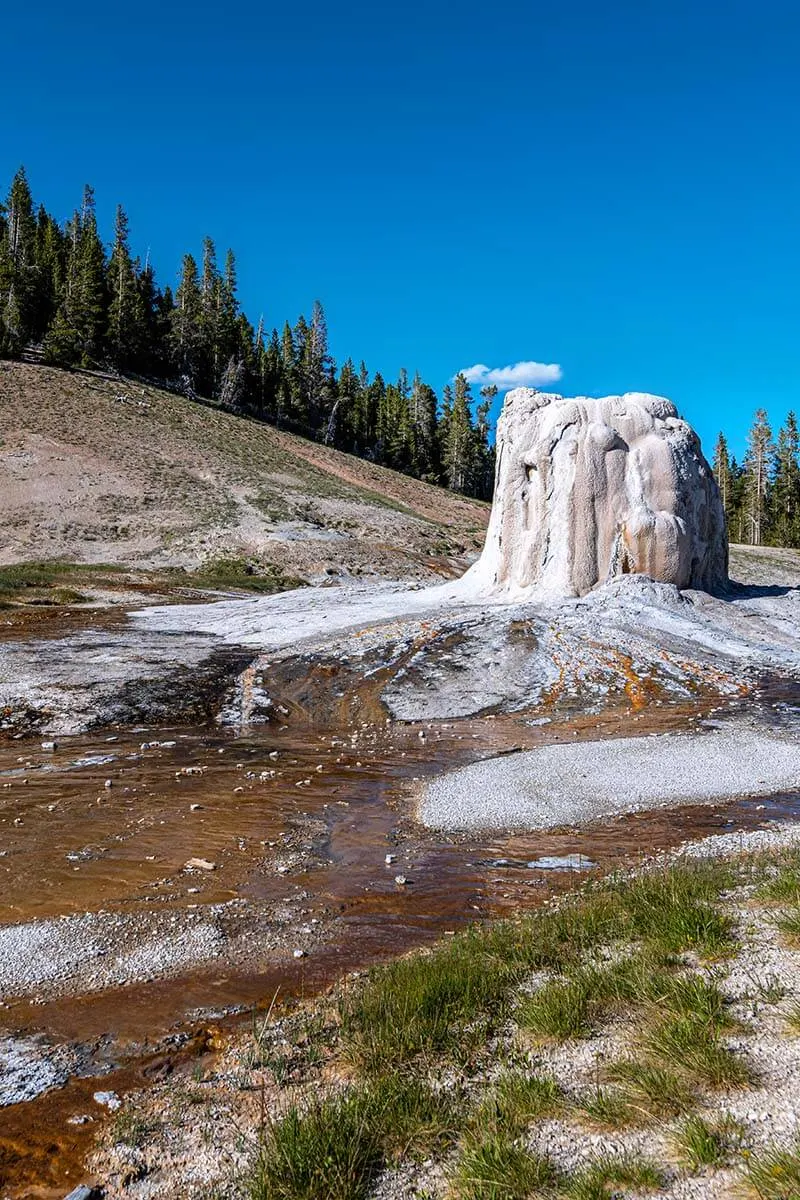
Map of Yellowstone South Loop Attractions
To give you a better idea of where everything is located, we created a map indicating all the best places to see on the lower loop of Yellowstone. See below.
As you can see, we indicated the main sights in different colors, so that you can decide what’s worth your time the most depending on how much time you have in the park.
Of course, you have to see the musts such as the Old Faithful, Grand Prismatic Spring, or Yellowstone Canyon. But there are so many other beautiful places that are also worth it and even if you get just a bit off the beaten path, it will make your visit to Yellowstone so much more memorable.
The added bonus is that there are hardly any people at the less popular places, especially the ones that require some walking to get to. Be sure to also check our article for some tips for visiting Yellowstone.
How to use this map: Use your computer mouse (or fingers) to zoom in or out. Click on the icons to get more information about each place. Click the arrow on the top left corner for the index. Click the star next to the map’s title to add it to your Google Maps account. To view the saved map on your smartphone or PC, open Google Maps, click the menu and go to ‘Your Places’/’Maps’. If you want to print the map or see it in a bigger window, click on ‘View larger map’ in the top right corner.
Where to Stay
Unless you can secure accommodation at one of the lodges inside Yellowstone, the best place to stay for sightseeing along the lower loop is the town of West Yellowstone. It’s about 25-30 miles, 40-50 minutes drive from Grand Prismatic Spring and the Old Faithful area, and a bit over 1 hour from Yellowstone Canyon.
In town, you’ll also find some attractions, theaters, and museums. Don’t miss Grizzly & Wolf Discovery Center and check out the Zipline Adventure Park.
There are also many companies offering Yellowstone tours from here. This is the most popular day tour from West Yellowstone. On Viator, you can find a bigger selection of tours from West Yellowstone.
Here are some of the best hotels in West Yellowstone for all budgets:
- $$$$$ Yellowstone Park Hotel.
- $$$$ Clubhouse Inn (one of the best options price-quality wise).
- $$$ Three Bear Lodge.
- $$ Al’s Westward Ho Motel.
- $ Brandin’ Iron Inn.
So, this is our guide to the best places to see and things to do on Yellowstone’s lower loop.
We hope that this helps you plan your visit to the park and inspires you to get a bit off the beaten path. There is so much more to Yellowstone than just its most popular attractions!
TIP: To help you make the most of your visit to the park, check out our tips and tricks for visiting Yellowstone. We also have lots of other guides. You can find some of them via the links below, and you can also see an overview of all our guides on this Yellowstone travel page.
Have a great trip!
More information for your trip to Yellowstone:
- What to do: Best Places to See in Yellowstone
- When to go: Best Time to Visit Yellowstone
- Tours: Best Yellowstone Tours
- Itinerary: Yellowstone Itinerary Suggestions for 1 to 5 Days
- Quick visit: Best of Yellowstone in 1 Day & Yellowstone in 2 Days
- Accommodation: Where to Stay in Yellowstone & Best Hotels near Yellowstone
- For families: Yellowstone with Kids
- What to pack: Yellowstone Packing List
- Nearby: One Day in Grand Teton & Things to Do in Jackson Hole
If you found this post helpful, don’t forget to bookmark it and share it with your friends. Are you on Pinterest? Pin these images!
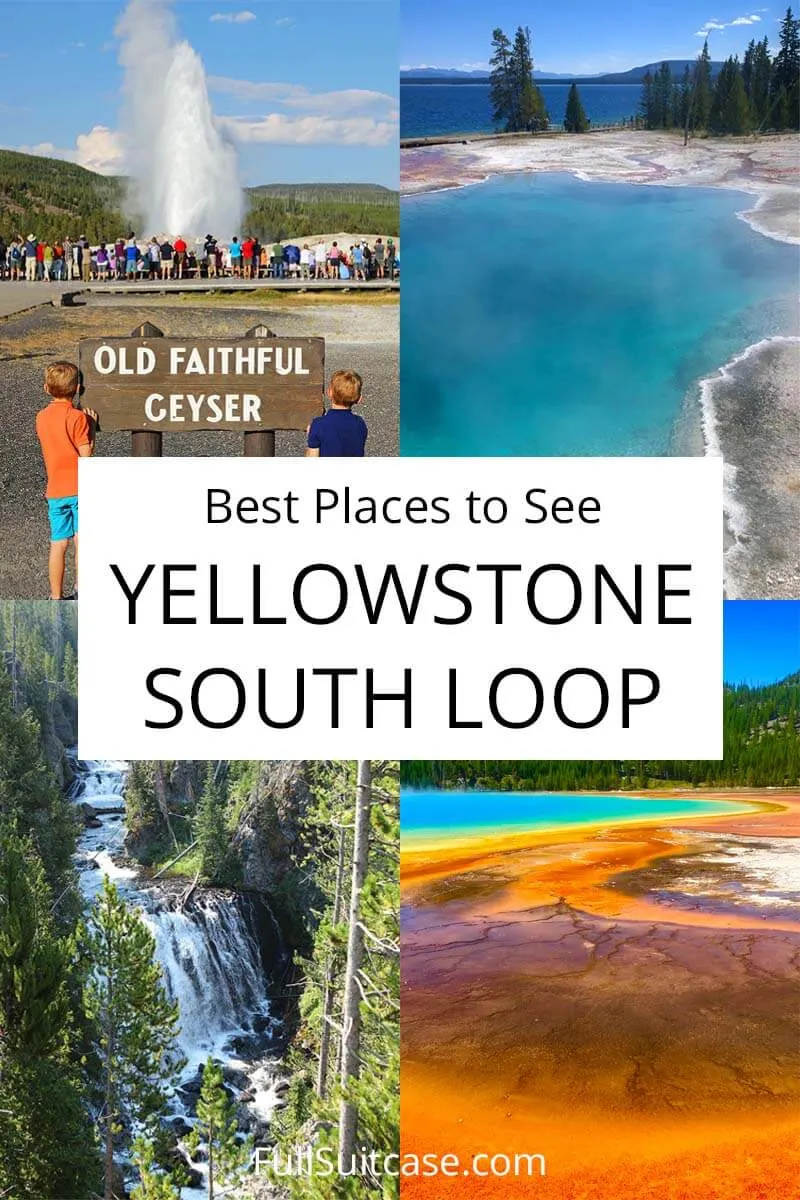
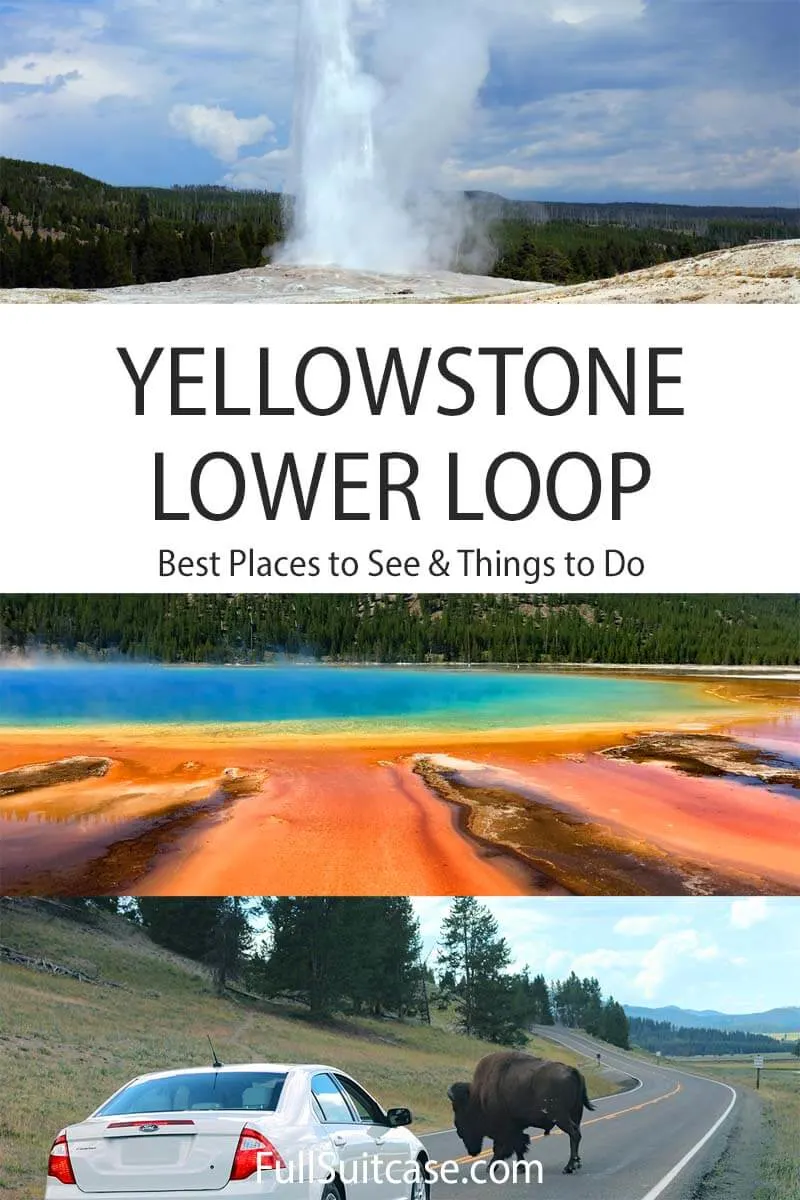

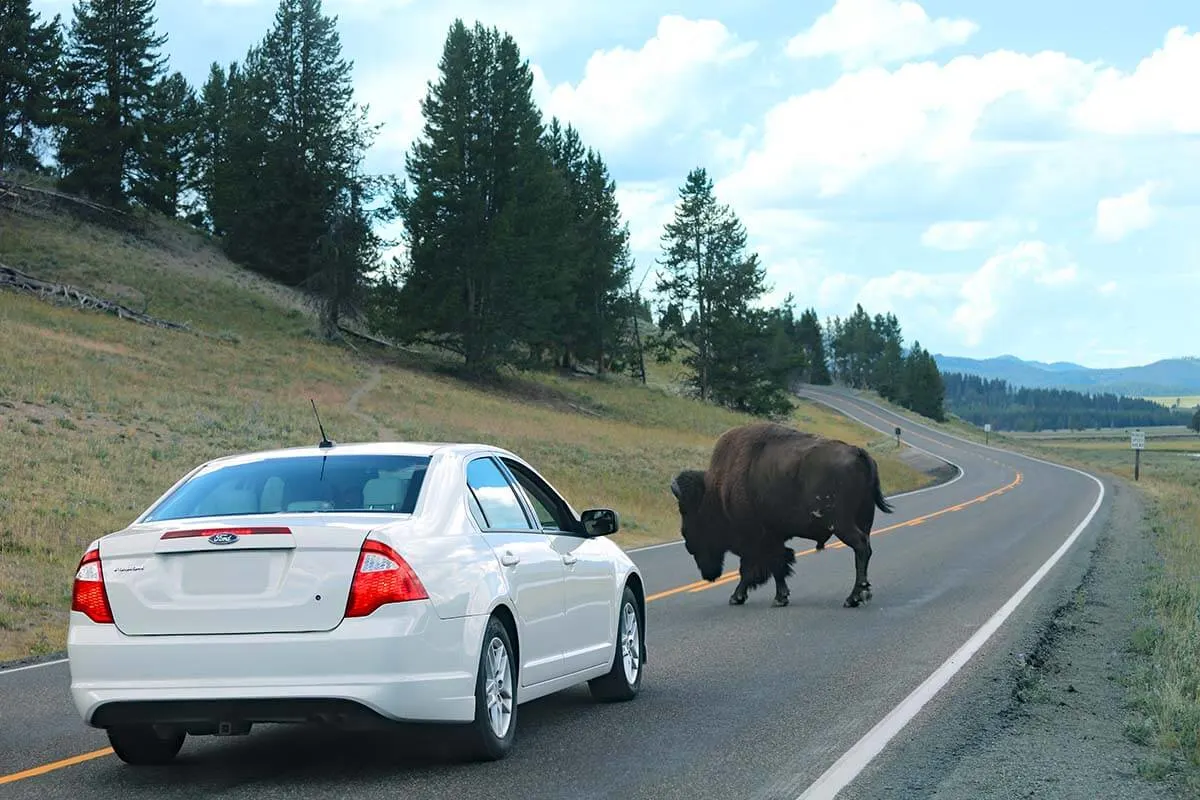
Ben Edelman
Wednesday 2nd of November 2022
Is it possible to get each of these guides, particularly the maps, in printable form? We have an adult daughter with autism and it helps to have printed materials of the plan for the area/day.
Thanks
Jurga
Sunday 6th of November 2022
Hi Ben, the map in this article is interactive, so you can print it straight from Google Maps if you want to. Alternatively, you can find all kinds of maps on the official National Parks website and you can print them out and indicate whichever places you want on paper. You'll also find paper maps once you enter the park and at the visitor centers. Hope this helps.
Kitty
Wednesday 3rd of August 2022
So far I have taken all of your accomodation advice on OF and Canyon Ridge and made my reservation. I will reviste your blog sometime this winter when planning our trip in June 2023. We are a family of 4 traveling from Chicago, any advise is welcomed. Thank you for all of your efforts!
Jurga
Wednesday 3rd of August 2022
Hi Kitty, I assume you meant Canyon Lodge - yes, that's a great place to stay in Yellowstone, just as the OF area. For more tips, please see our Yellowstone travel page - it has an overview of all our guides to the area that you might find useful as the trip approaches closer. Happy travels!
Cindy Dizon
Tuesday 28th of June 2022
I have so enjoyed your blog and it was super helpful!! We visited today and it helped us immensely! One thing to note is that the Firehole area (Lake drive/swim and falls) area all closed - it was impacted by the floods. Also Uncle Tom's Point is closed (I guess it has been for while).
Jurga
Wednesday 29th of June 2022
Glad to hear this, Cindy. And thank you for sharing this info - it will be helpful to other people planning a visit at this moment. I just want to add that there is always something closed in Yellowstone for repairs, due to wildlife, and also for other reasons. They only have a few warm months when all the infrastructure has to be updated, so every summer, you'll have some closures for planned repairs, etc. Plus, all those unforeseen closures due to the floods this year. That's why we always advise checking the 'current conditions' page on the official website for up-to-date information.